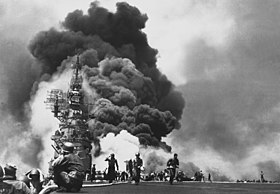
Back كاميكازي Arabic كاميكاز ARZ কামিকাজি Assamese Kamikaze AST Kamikadze Azerbaijani Kamikaze BCL Камикадзе Bulgarian কামিকাযি Bengali/Bangla Kamikaza BS Kamikaze Catalan

Kamikaze (神風, pronounced [kamiꜜkaze]; 'divine wind'[2] or 'spirit wind'), officially Shinpū Tokubetsu Kōgekitai (神風特別攻撃隊, 'Divine Wind Special Attack Unit'), were a part of the Japanese Special Attack Units of military aviators who flew suicide attacks for the Empire of Japan against Allied naval vessels in the closing stages of the Pacific campaign of World War II, intending to destroy warships more effectively than with conventional air attacks. About 3,800 kamikaze pilots died during the war, and more than 7,000 naval personnel were killed by kamikaze attacks.[3]
Kamikaze aircraft were essentially pilot-guided explosive missiles, purpose-built or converted from conventional aircraft. Pilots would attempt to crash their aircraft into enemy ships in what was called a "body attack" (tai-atari) in aircraft loaded with bombs, torpedoes, and/or other explosives. About 19% of kamikaze attacks were successful.[3] The Japanese considered the goal of damaging or sinking large numbers of Allied ships to be a just reason for suicide attacks; kamikaze was more accurate than conventional attacks, and often caused more damage. Some kamikazes were still able to hit their targets even after their aircraft had been crippled.
The attacks began in October 1944, at a time when the war was looking increasingly bleak for the Japanese. They had lost several important battles, many of their best pilots had been killed, their aircraft were becoming outdated, and they had lost command of the air. Japan was losing pilots faster than it could train their replacements, and the nation's industrial capacity was diminishing relative to that of the Allies. These factors, along with Japan's unwillingness to surrender, led to the use of kamikaze tactics as Allied forces advanced towards the Japanese home islands.
The tradition of death instead of defeat, capture, and shame was deeply entrenched in Japanese military culture; one of the primary values in the samurai life and the Bushido code was loyalty and honor until death.[4][5][6][7] In addition to kamikazes, the Japanese military also used or made plans for non-aerial Japanese Special Attack Units, including those involving Kairyu (submarines), Kaiten (human torpedoes), Shinyo speedboats, and Fukuryu divers.
- ^ Bunker Hill CV-17, NavSource Online: Aircraft Carrier Photo Archive
- ^ Wragg, David W. (1973). A Dictionary of Aviation (first ed.). Osprey. p. 171. ISBN 9780850451634.
- ^ a b Zaloga, Steve (2011). Kamikaze: Japanese Special Attack Weapons 1944–45. New Vanguard. Osprey Publishing. p. 12. ISBN 978-1849083539.
- ^ David Powers, "Japan: No Surrender in World War Two"
- ^ John W. Dower, War Without Mercy: Race & Power in the Pacific War pp. 1, 216 ISBN 039450030X
- ^ Haruko Taya Cook and Theodore F. Cook, Japan at War: An Oral History p. 264 ISBN 1565840143
- ^ Meirion and Susie Harries, Soldiers of the Sun: The Rise and Fall of the Imperial Japanese Army p. 413 ISBN 0394569350
© MMXXIII Rich X Search. We shall prevail. All rights reserved. Rich X Search

